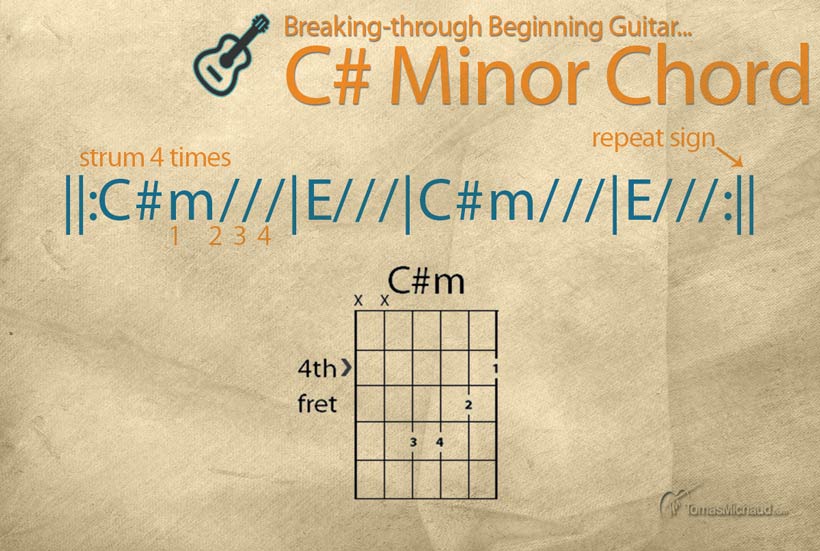
Welcome To Breaking-Through Beginning Guitar
Welcome to my Breaking-through Beginning Guitar series. If you're new to this series it's the designed to teach some of the elements that are just beyond what beginners learn and to help you move into that next stage beyond brand-new beginner on the guitar.
WHY C#m?
In this lesson you're going to learn the C sharp minor chord. This chord is a little more difficult than most of the basic open chords that you learn as a beginning guitarist. It's more difficult because there's no way to play it using open strings.
The C sharp minor is often played as a bar chord, but in this lesson you're going to learn a form that can be played without a bar using four fingers.
Can I Use The Bar Form Of C#m?
There's nothing wrong with playing C#m as a bar chord. However the form that I'm going to show you today is a little easier and it's still useful even if you know how to play the bar chord. You'll find over time that different forms of the chords sound better depending on the other chords in the song and the sound that you're going for.
In the case of the four finger form of the C sharp minor chord this works well when you're playing other chords that are not using a lot of bass notes. Because you're not using the fifth or sixth string in this chord it sounds higher in frequency. You’re using higher frequency notes.
It's particularly helpful when you're playing in the group with a bass player. When playing full chords with notes on the 5th and 6th strings it can be difficult not to play notes that conflict with what the bass player is playing. You don't want to clash with the bass player 🙂
This whole area of deciding when and where to play different forms of the chord is called chord voicing and is a worthy study in and of itself.
So enough theory… let's get on with playing the C# minor chord.
Getting Down To “Chord” Business
To play the C#m put your first finger on the first string, fourth fret. Now place your third and fourth fingers down together on the fourth and third strings, sixth fret. Finally place your second finger down on the second string, fifth fret. You'll want to avoid striking the fifth and six strings.
Strum the chord. Now play each of the notes individually to see if there are any dead notes. Make some adjustments to try to improve the sound if appropriate. After about a minute of this take your hand off and start over.
After you practice the chord this way for a while it's best to start practice it moving from one chord to another. I've included an exercise that moves from the C sharp minor chord to the E chord. If you practice this a little each day you'll find that not only can you play the C sharp minor more easily, but you'll start to put all your fingers down at the same time. Learning to place your fingers down together instead of one or two at a time will improve how quickly and smoothly you can change chords.

Once you learn the C sharp minor chord you can use the same chord form to play many other chords that use the same form. For example, if you move this entire chord down one fret it becomes a C minor chord. If you move the whole form up one fret it becomes a D minor chord.
Next Level Exercise
At the end of the video I've included another exercise which is more difficult than the one I described above. It uses a another breakthrough chord… The B-flat major chord (also spelled Bb). If you're new to this chord I've created another breakthrough lesson to help you learn this one: Breaking-through With The B flat Major Chord for Guitar
Tell Us What You Think - Please Comment Below!
We would love to hear your comments and questions. What specific things are you struggling with while learning guitar?

It sound like are saying blog. if it is a blog you are mention where to find more stuff
Where is it how do I get there? LOL Thanks
Hi Melvin,
You can get more of Tomas Michaud’s great guitar lessons and tips.
Sign up for email updates at https://tomasmichaud.com – It’s FREE!
Hazel
Starland Guitar
Customer Support
Thank you! I get a lot from your videos. I’ve been playing a long time, but I’ve allowed myself to sidestep the harder parts. Lately I’ve been going back to fill in the difficult blanks. The G chord with the pinkie on the high E still tasks me: My pinkie will not go there unless it’s the first finger placed, and even then it’s a struggle. Do you have any Tomas Tips to making this easier?